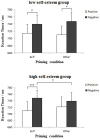Modulation of self-esteem in self- and other-evaluations primed by subliminal and supraliminal faces
- PMID: 23091607
- PMCID: PMC3473034
- DOI: 10.1371/journal.pone.0047103
Modulation of self-esteem in self- and other-evaluations primed by subliminal and supraliminal faces
Abstract
Background: Past research examining implicit self-evaluation often manipulated self-processing as task-irrelevant but presented self-related stimuli supraliminally. Even when tested with more indirect methods, such as the masked priming paradigm, participants' responses may still be subject to conscious interference. Our study primed participants with either their own or someone else's face, and adopted a new paradigm to actualize strict face-suppression to examine participants' subliminal self-evaluation. In addition, we investigated how self-esteem modulates one's implicit self-evaluation and validated the role of awareness in creating the discrepancy on past findings between measures of implicit self-evaluation and explicit self-esteem.
Methodology/principal findings: Participants' own face or others' faces were subliminally presented with a Continuous Flash Suppression (CFS) paradigm in Experiment 1, but supraliminally presented in Experiment 2, followed by a valence judgment task of personality adjectives. Participants also completed the Rosenberg Self-Esteem Scale in each experiment. Results from Experiment 1 showed a typical bias of self-positivity among participants with higher self-esteem, but only a marginal self-positivity bias and a significant other-positivity bias among those with lower self-esteem. However, self-esteem had no modulating effect in Experiment 2: All participants showed the self-positivity bias.
Conclusions/significance: Our results provide direct evidence that self-evaluation manifests in different ways as a function of awareness between individuals with different self-views: People high and low in self-esteem may demonstrate different automatic reactions in the subliminal evaluations of the self and others; but the involvement of consciousness with supraliminally presented stimuli may reduce this dissociation.
Conflict of interest statement
Figures



Similar articles
-
Lower self-positivity and its association with self-esteem in women with borderline personality disorder.Behav Res Ther. 2018 Oct;109:84-93. doi: 10.1016/j.brat.2018.07.008. Epub 2018 Aug 2. Behav Res Ther. 2018. PMID: 30165335
-
Deficits of subliminal self-face processing in schizophrenia.Conscious Cogn. 2020 Mar;79:102896. doi: 10.1016/j.concog.2020.102896. Epub 2020 Feb 20. Conscious Cogn. 2020. PMID: 32088607
-
Age invariance in rapid facial affective reactions to emotionally valenced stimuli.Q J Exp Psychol (Hove). 2018 Aug;71(8):1687-1697. doi: 10.1080/17470218.2017.1345960. Epub 2018 Jan 1. Q J Exp Psychol (Hove). 2018. PMID: 28644071
-
Don't make me angry, you wouldn't like me when I'm angry: Volitional choices to act or inhibit are modulated by subliminal perception of emotional faces.Cogn Affect Behav Neurosci. 2017 Apr;17(2):252-268. doi: 10.3758/s13415-016-0477-5. Cogn Affect Behav Neurosci. 2017. PMID: 27921217
-
The paranoia as defence model of persecutory delusions: a systematic review and meta-analysis.Lancet Psychiatry. 2018 Nov;5(11):913-929. doi: 10.1016/S2215-0366(18)30339-0. Epub 2018 Oct 9. Lancet Psychiatry. 2018. PMID: 30314852
Cited by
-
Lonely Individuals Do Not Show Interpersonal Self-Positivity Bias: Evidence From N400.Front Psychol. 2018 Apr 6;9:473. doi: 10.3389/fpsyg.2018.00473. eCollection 2018. Front Psychol. 2018. PMID: 29681875 Free PMC article.
-
The multisensory basis of the self: From body to identity to others [Formula: see text].Q J Exp Psychol (Hove). 2017 Apr;70(4):597-609. doi: 10.1080/17470218.2016.1181768. Epub 2016 May 17. Q J Exp Psychol (Hove). 2017. PMID: 27100132 Free PMC article.
-
Self-esteem modulates the time course of self-positivity bias in explicit self-evaluation.PLoS One. 2013 Dec 5;8(12):e81169. doi: 10.1371/journal.pone.0081169. eCollection 2013. PLoS One. 2013. PMID: 24339908 Free PMC article.
-
Does Implicit Self-Reference Effect Occur by the Instantaneous Own-Name?Front Psychol. 2021 Oct 4;12:709601. doi: 10.3389/fpsyg.2021.709601. eCollection 2021. Front Psychol. 2021. PMID: 34671294 Free PMC article.
-
Self-esteem modulates dorsal medial prefrontal cortical response to self-positivity bias in implicit self-relevant processing.Soc Cogn Affect Neurosci. 2014 Nov;9(11):1814-8. doi: 10.1093/scan/nst181. Epub 2014 Jan 5. Soc Cogn Affect Neurosci. 2014. PMID: 24396003 Free PMC article.
References
-
- Banaji MR, Prentice DA (1994) The self in social contexts. Annu Rev Psychol 45: 297–332.
-
- Pahl S, Eiser JR (2005) Valence, comparison focus, and self-positivity biases: Does it matter whether people judge positive or negative traits? Exp Psychol 52: 303–310. - PubMed
-
- Perloff LS, Fetzer BK (1986) Self-other judgments and perceived vulnerability to victimization. J Pers Soc Psychol 50: 502–510.
-
- Jame W (1890) Principle of Psychology, 1. New York: Henry Holt.
-
- Alicke MD (1985) Global self-evaluation as determined by the desirability and controllability of trait adjectives. J Pers Soc Psychol 49: 1621–1630.
Publication types
MeSH terms
LinkOut - more resources
Full Text Sources
Miscellaneous

